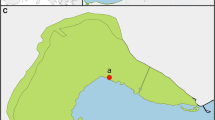Abstract
After an extreme flood in Lake Constance in 1999 the Phragmites australisbelt showed a severe decline in area and vitality. A three year monitoring project was installed in 2000 to document the die-back and rehabilitation process immediately afterwards, to identify the co-factors of the damage, and to find out significant stressors that may impede the recovery of the reeds. The monitoring is based on CIR aerial photo interpretation, quantitative GIS analyses and field investigations on shoot density, stand structure and biomass production in 50 monitoring plots, grouped in five degrees of damage. In result we found that c. 0.306 km2 of aquatic reed bed area died back at Lake Constance-Untersee (i.e. 23% of the former area in 1998). Among the stands which had survived the severely damaged stands were mainly composed of secondary shoots, whereas primary and insect infested shoots dominated in less damaged stands. The development from 2000 to 2001 was characterized by an overall decrease in shoot density, a change in the composition of the shoot population in favour of primary shoots, and in a recovery in culm stature. All variables depended on the degree of initial damage by the extreme flood. A conceptual model is proposed to assess the future development of Lake Constance reeds.
Similar content being viewed by others
References
Brändle, R., 1983. Evolution der Gärungskapazität in den flut-und anoxiatoleranten Rhizomen von Phalaris arundinacea, Phragmites communis, Schoenoplectus lacustris und Typha latifolia. Botanica Helvetica 93: 39–45.
Brändle, R., 1985. Kohlenhydratgehalt und Vitalität isolierter Rhizome von Phragmites australis, Schoenoplectus lacustris und Typha latifolia nach mehrwöchigem O2-Mangelstress. Flora 177: 317–321.
Brändle, R. & R. M. M. Crawford, 1987. Rhizome anoxia tolerance and habitat specialization in wetland plants. In Crawford R. M. M. (ed.), Plant Life in Aquatic and Amphibious Habitats, pp. 397–410. Blackwell.
Brix, H., 1999. The European Research Project on Reed Die-back and Progression (EUREED). Limnologica 29: 5–10.
Conert, H. J., 1998. Phragmites. In Hegi, G. Illustrierte Flora von Mitteleuropa. Vol. I/3. 3rd ed. Parey Publ. Berlin: 126–133.
Dienst, M., 1986. Zur Dynamik der Schilffront am Bodensee-Untersee. Natur und Landschaft 61: 137–139.
Hürlimann, H., 1951. Zur Lebensgeschichte des Schilfs an den Ufern der Schweizer Seen. Beitr. Geobot. Landesaufnahme Schweiz 30: 232 pp.
Ostendorp, W., 1989. ‘Die-back’ of reeds in Europe-A critical review of literature. Aquatic Botany Amsterdam 35: 5–26.
Ostendorp, W., 1990. Die Ursachen des Röhrichtrückgangs am Bodensee-Untersee. Carolinea 48: 85–102.
Ostendorp, W., 1993. Schilf als Lebensraum. Beih. Veröff. Naturschutz Landschaftspflege Baden-Württemberg 68: 173–280.
Ostendorp, W., H. Stark, P. Krumscheid-Plankert & A. Pier, 1996. Dynamics and restoration of lakeside reedbelts in a prealpine lake (Lake Constance, Germany). Proceedings of Ecohydraulics, Quebec, June 1996: B753–B765.
Rodewald-Rudescu, L., 1974. Das Schilfrohr Phragmites communis Trin. Die Binnengewässer 27: 302 S.. Stuttgart.
Scheirer, C. J., W. S. Ray & N. Hare, 1976. The analysis of ranked data derived from completely randomized factorial designs. Biometrics 32: 429–434.
Schmieder, K., M. Dienst & W. Ostendorp, 2002. Auswirkungen des Extremhochwassers 1999 auf die Flächendynamik und Bestandsstruktur der Uferröhrichte des Bodensees. Limnologica 31: 131–146.
Studer, C. & R. Brändle, 1984. Sauerstoffkonsum und –versorgung der Rhizome von Acorus calamus, Glyceria maxima, Menyanthes trifoliata, Phalaris arundinacea, Phragmites communis und Typha latifolia. Botanica Helvetica 94: 23–31.
Urbanska, K. M., 1992. Populationsbiologie der Pflanzen: 374 pp,G. Fischer, Stuttgart.
Van der Putten, W. H., 1997. Die-back of Phragmites australis in European wetlands: an overview of the European Research programme on Reed Die-back and progression (1993–1994). Aquat. Bot. 59: 263–275.
White, P. S. & A. Jentsch, 2001. The search for generality in studies of disturbance and ecosystems dynamics. Progress in Botany 62: 399–450.
White, P. S. & S. T. A. Pickett (eds), 1985. The Ecology of Natural Disturbance and Patch Dynamics. Academic Press, New York.
Author information
Authors and Affiliations
Rights and permissions
About this article
Cite this article
Ostendorp, W., Dienst, M. & Schmieder, K. Disturbance and rehabilitation of lakeside Phragmites reeds following an extreme flood in Lake Constance (Germany). Hydrobiologia 506, 687–695 (2003). https://doi.org/10.1023/B:HYDR.0000008622.60094.6d
Published:
Issue Date:
DOI: https://doi.org/10.1023/B:HYDR.0000008622.60094.6d




